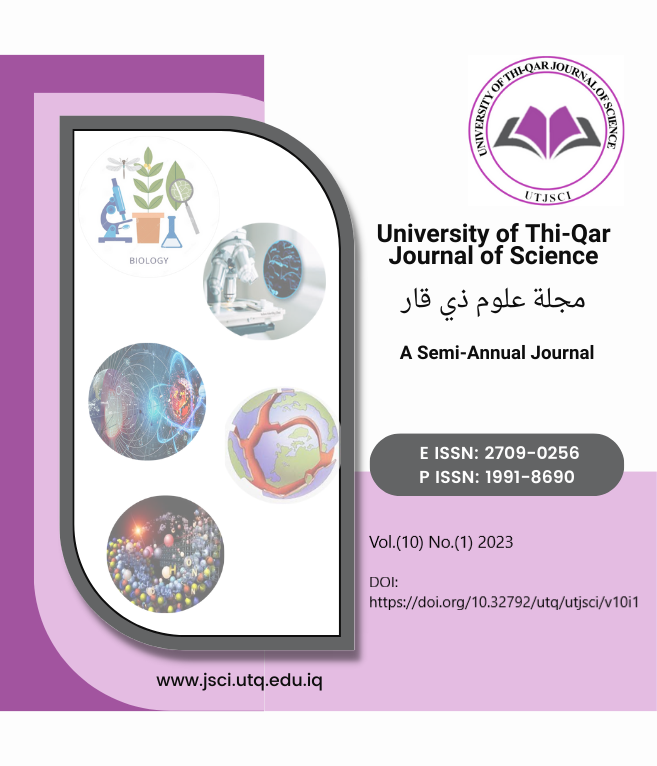An Effect entomopathogenic fungi in control Culex pipiens
DOI:
https://doi.org/10.32792/utq/utjsci/v10i1.920Keywords:
Culex pipiens, Beauveruia bassiana, Trichoderma harizanium, entomopathogenic fungi.Abstract
Culex pipiens mosquitos are thought to be vectors for many arboviruses, including West Nile virus and encephalitis virus, which have a global impact on human health. The natural management of this pest's aquatic stages is critical for sustaining an insecticide-free environment. The current study focused on the biological and biochemical effects of the entomopathogenic fungi Beauveria bassiana and Trichoderma harizanium on Culex pipiens laboratory colony 3rd instar larvae. The results showed that B. bassiana had the highest larval mortality (22%) with the concentration 1x106 spore/ml and the period exposure recorded (36.6% )shortest lethal time (120 hrs), followed by T. harizanium (17.3%) with concentration 1x107 spore/ml and the period exposure recorded (29.1%) shortest lethal time (120 hrs), and had the lowest percent mortality (16%) with the concentration 1x103 spore/ml and period exposure with (6%) longest (24 hrs) for B. bassiana and had the lowest percent mortality (4%) with the concentration 1x103 spore/ml for T. harizanium and period exposure with 24 hrs (12.5%).
References
Qin, X., Zhao, X., Huang, S., Deng, J., Li, X., Luo, Z., & Zhang, Y. (2021). Pest management via endophytic colonization of tobacco seedlings by the insect fungal pathogen Beauveria bassiana. Pest Management Science, 77(4), 2007-2018.
Hamid, S. O. N. I. A., Halouane, F. A. T. M. A., Bissaad, F. Z., & Benzina, F. A. R. I. D. A. (2013). Study about the effect of Beauveria bassiana (Vuillemin IN 1912) on the aquatic stages of Culex pipiens (LINNÉ, 1758).
Ziani, J., 2008. Application de Beauveria bassiana contre la punaise terne Lygus lineolaris(Palisot de Beauvois)(Hémiptères: Miridés) dans les vignobles. Thesis.
Benserradj, O., Mihoubi, I., 2014. Larvicidal activity of entomopathogenic fungi Metarhizium anisopliae against mosquito larvae in Algeria. Int. J. Curr. Microbiol. Appl. Sci 3, 54-62.
Loc, N.T., Chi, V.T.B., Nhan, N.T., Hong, T.T.B., Chi, N.T.P., Nghia, N.T., 2010. Exploitation of Beauveria bassiana and Metarhizium anisopliae as potential biocontrol agents in integrated pest management (ipm) on citrus. Omonrice 17, 152-163.
Farenhorst, M., Knols, B.G., 2007. Fungal entomopathogens for the control of adult mosquitoes: a look at the issues, Proceedings of the Netherlands Entomological Society meeting, pp. 51-59.
Sabouraud, R., 1982. Ann. Dermatol. Syphilol. 3:1061.
Osman, M., Stigloher, C., Mueller, M.J., Waller, F., 2020. An improved growth medium for enhanced inoculum production of the plant growth-promoting fungus Serendipita indica. Plant methods 16, 1-7.
Alagawany, M., Madkour, M., El-Saadony, M.T., Reda, F.M., 2021b. Paenibacillus polymyxa (LM31) as a new feed additive: Antioxidant and antimicrobial activity and its effects on growth, blood biochemistry, and intestinal bacterial populations of growing Japanese quail. Anim. Feed Sci. Technol. 276, 114920.
Haron, E.N., Ahmed, M., Ali, S.S., Abas, A.A., Elshaier, M.E., 2020. Evaluate the effects of entomopathogenic fungi isolates on Wheat Aphid, Schizaphis graminu (Rondani)(Hemiptera: Aphididae). Egypt. Acad. J. Biol. Sci.. A, Entomology 13, 149-159.
Javed, K., Javed, H., Mukhtar, T., Qiu, D., 2019. Pathogenicity of some entomopathogenic
fungal strains to green peach aphid, Myzus persicae Sulzer (Homoptera: Aphididae).
Egypt J. Biol. Pest Control 29, 1-7.
Saad, A.M., Mohamed, A.S., El-Saadony, M.T., Sitohy, M.Z., 2021. Palatable functional
cucumber juices supplemented with polyphenols-rich herbal extracts. LWT - Food Sci.
Technol. 148, 111668.
Scholte, E. J., Njiru, B. N., Smallegange, R. C., Takken, W., & Knols, B. G. (2003). Infection of malaria (Anopheles gambiae ss) and filariasis (Culex quinquefasciatus) vectors with the entomopathogenic fungus Metarhizium anisopliae. Malaria journal, 2(1), 1-8.
Vega, F. E., & Dowd, P. F. (2005). The role of yeasts as insect endosymbionts. Insect-fungal associations: ecology and evolution, 211-243.
Gayathri, G., Balasubramanian, C., Moorthi, P. V., & Kubendran, T. (2010). Larvicidal potential of Beauveria bassiana (Balsamo) Vuillemin and Paecilomyces fumosoroseus (Wize,) Brown and Smith on Culex quinquefasciatus (Say). Journal of Biopesticides, 3(1), 147.
Mc Innis Jr, T., & Zattau, W. C. (1982). Experimental infection of mosquito larvae by a species of the aquatic fungus Leptolegnia. Journal of Invertebrate Pathology, 39(1), 98-104.
Bukhari, T., Middelman, A., Koenraadt, C. J., Takken, W., & Knols, B. G. (2010). Factors affecting fungus-induced larval mortality in Anopheles gambiae and Anopheles stephensi. Malaria journal, 9(1), 1-15.
Foo, K., Sathiya Seelan, J. S., & Dawood, M. M. (2017). Microfungi associated with Pteroptyx bearni (Coleoptera: Lampyridae) eggs and larvae from Kawang River, Sabah (Northern Borneo). Insects, 8(3), 66.
Jaronski, S. T. (2023). Mass production of entomopathogenic fungi—state of the art. Mass production of beneficial organisms, 317-357.
Lacey, C. M., Lacey, L. A., & Roberts, D. R. (1988). Route of invasion and histopathology of Metarhizium anisopliae in Culex quinquefasciatus. Journal of invertebrate pathology, 52(1), 108-118.
Downloads
Published
License
Copyright (c) 2023 University of Thi-Qar Journal of Science

This work is licensed under a Creative Commons Attribution 4.0 International License.













